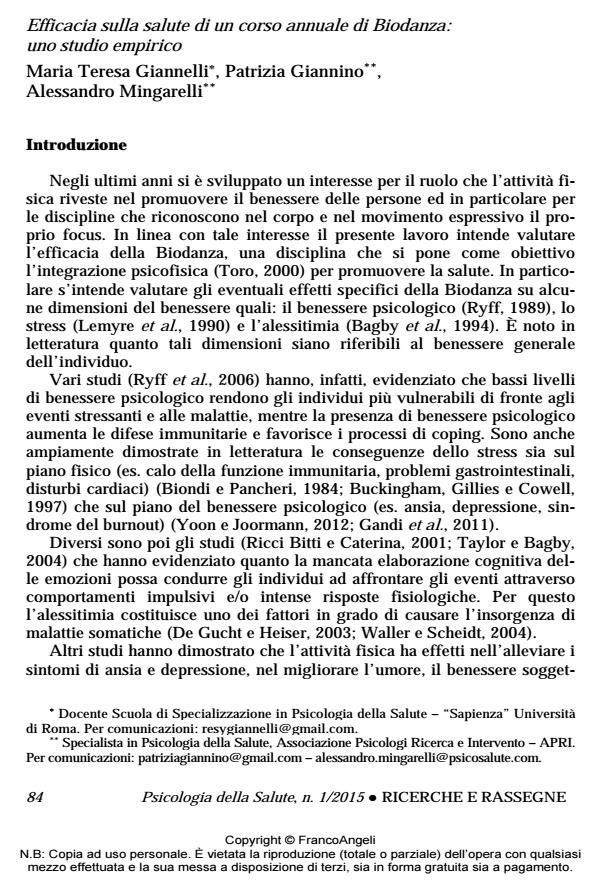Effectiveness on the health of an annual course of Biodanza: empirical study with 235 people
Journal title PSICOLOGIA DELLA SALUTE
Author/s Maria Teresa Giannelli, Patrizia Giannino, Alessandro Mingarelli
Publishing Year 2015 Issue 2015/1
Language Italian Pages 24 P. 84-107 File size 350 KB
DOI 10.3280/PDS2015-001009
DOI is like a bar code for intellectual property: to have more infomation
click here
Below, you can see the article first page
If you want to buy this article in PDF format, you can do it, following the instructions to buy download credits

FrancoAngeli is member of Publishers International Linking Association, Inc (PILA), a not-for-profit association which run the CrossRef service enabling links to and from online scholarly content.
Biodance is a discipline which is proposed as a path of personal growth and development with the goal of promoting individual well-being. The study has evaluated the specific effects of Biodance on various dimensions of well-being such as: psychological well-being, stress and alexithymia. There were 235 participants involved in this study, divided into three groups, the first is an experimental group and the two others are control groups. The experimental group Biodance, is made up of 96 participants who started a bio-dance course for the first time; 71 participants who started a dance course constitute the Physical Activity control group and the Sedentary control group, consisting of 68 participants, did not practice any physical activity. The data collection was done through three questionnaires filled out over two periods of time: at the beginning (pre-test) and at the end of the courses, which lasted for about 9 months (post-test). The scales used for the data collection were the following: the Psychological Well-Being Scale used to evaluate individual well-being, the Measure du Stress Psychologique to measure stress and Toronto Alexithymia Scale, to evaluate the alexithymia. The results highlighted that participants of the Biodance group, after one year of taking the course, show an improvement of their psychological well-being and a decreased of level of stress and minor level of alexithymia. However both Physical Activity and Sedentary control groups do not present significant variation between pre and post-test. To conclude, the results show that Biodance is indeed a practice to promote well-being and individual development.
Keywords: Biodance, well-being, stress, alexithymia.
- Holistic movement practices – An emerging category of physical activity for exercise psychology Ineke Vergeer, Mattias Johansson, Jonathan Y. Cagas, in Psychology of Sport and Exercise 101870/2021 pp.101870
DOI: 10.1016/j.psychsport.2020.101870 - Diversification of Physical Activities: An Exploration of Provision Characteristics of Holistic Movement Practices in a Large Australian City Ineke Vergeer, Bojana Klepac-Pogrmilovic, in International Journal of Environmental Research and Public Health /2021 pp.10365
DOI: 10.3390/ijerph181910365
Maria Teresa Giannelli, Patrizia Giannino, Alessandro Mingarelli, Efficacia sulla salute di un corso annuale di Biodanza: uno studio empirico in "PSICOLOGIA DELLA SALUTE" 1/2015, pp 84-107, DOI: 10.3280/PDS2015-001009